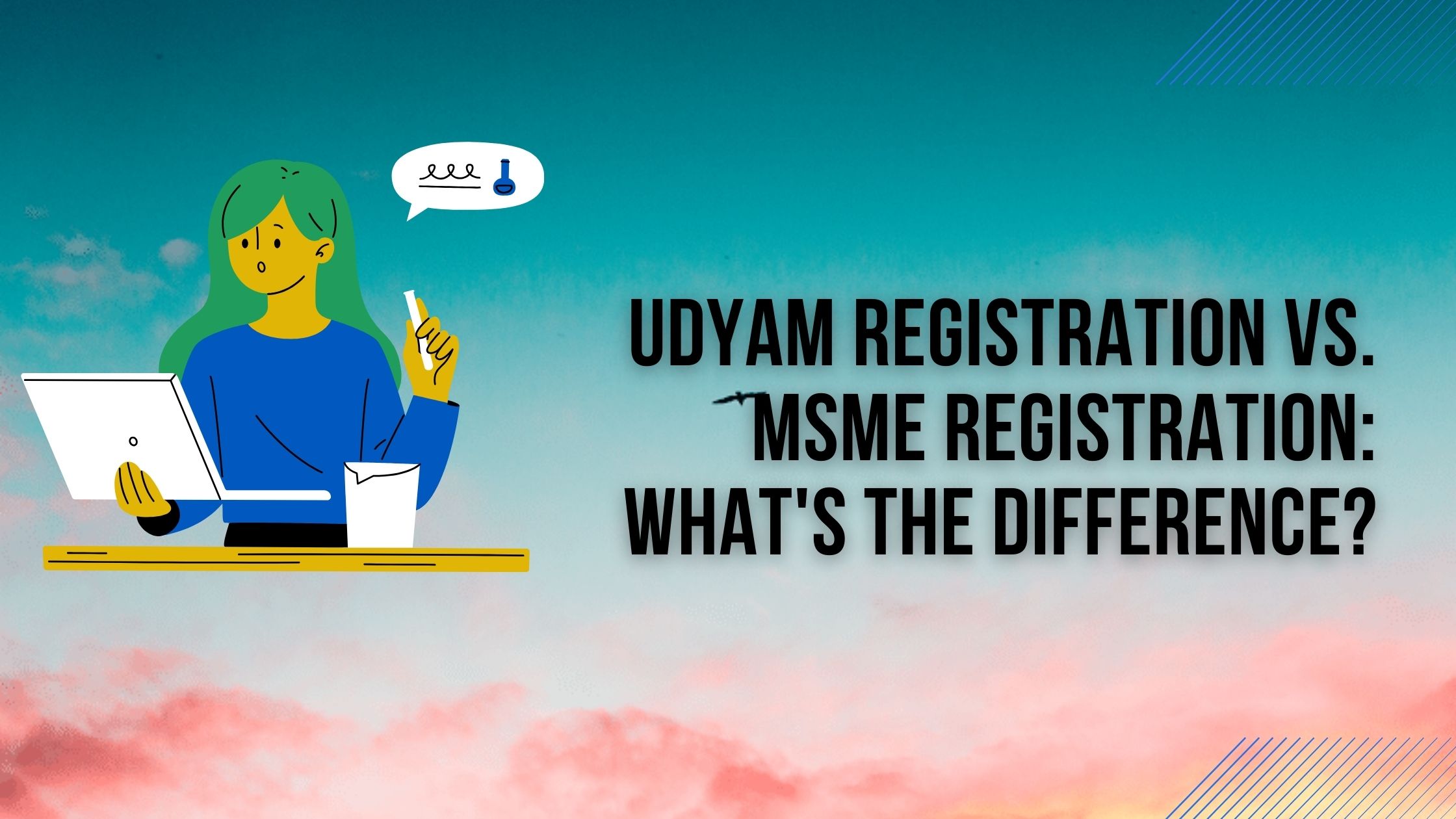In the ever-evolving landscape of business and entrepreneurship, navigating the regulatory requirements can be a daunting task. For small and medium-sized enterprises (SMEs) in India, understanding the distinctions between Udyam Registration and MSME Registration is crucial. These two registration processes serve distinct purposes and come with their own sets of benefits. In this article, we’ll break down the differences between Udyam Registration and MSME Registration to help you make informed decisions for your business.
Understanding Udyam Registration
What is Udyam Registration?
Udyam Registration is a government initiative introduced by the Ministry of Micro, Small and Medium Enterprises (MSME) in 2020. Its primary objective is to simplify the registration process for micro, small, and medium-sized enterprises. It replaced the earlier system of MSME registration and brought about significant changes.
Eligibility Criteria
To be eligible for Udyam Registration, a business must fall under the following criteria:
Micro, Small, or Medium Enterprise
- Microenterprise: Investment in plant and machinery or equipment should not exceed ₹1 crore.
- Small enterprise: Investment should be between ₹1 crore and ₹10 crore.
- Medium enterprise: Investment should be between ₹10 crore and ₹50 crore.
Benefits of Udyam Registration
- Easy Registration: The Udyam Registration process is entirely online, making it convenient and hassle-free for business owners.
- Financial Assistance: Registered enterprises can avail various government schemes and subsidies, such as low-interest rate loans and grants.
- Priority Lending: Banks are encouraged to provide loans to Udyam-registered businesses, leading to improved access to credit.
- Tax Benefits: Enterprises registered under Udyam can enjoy exemptions and deductions under the Income Tax Act.
- Global Recognition: Udyam Registration helps SMEs gain global recognition, making it easier to participate in international trade and collaborations.
Understanding MSME Registration
What is MSME Registration?
MSME Registration, on the other hand, was the traditional method of registering small and medium-sized enterprises. It existed before the introduction of Udyam Registration and served similar purposes.
Eligibility Criteria
The eligibility criteria for MSME Registration are:
Investment in Plant and Machinery
- Microenterprise: Up to ₹25 lakh.
- Small enterprise: Between ₹25 lakh and ₹5 crore.
- Medium enterprise: Between ₹5 crore and ₹10 crore.
Benefits of MSME Registration
- Business Credibility: MSME Registration lends credibility to your business, especially when dealing with banks and financial institutions.
- Government Tenders: Registered businesses can participate in government tenders and contracts, opening up new business opportunities.
- Financial Support: Similar to Udyam, MSME-registered enterprises can access various financial support schemes.
- Ease of Compliance: The compliance requirements for MSMEs are often more relaxed compared to larger enterprises.
- Marketing Assistance: MSMEs can benefit from government-sponsored marketing campaigns, which can boost their visibility.
Also Read: Difference Between Udyog Aadhaar & Udyam Registration
Key Differences
Now that we have a clear understanding of both registration processes, let’s highlight the key differences between Udyam Registration and MSME Registration:
1. Eligibility Criteria
- Udyam Registration is based on investment in plant and machinery or equipment.
- MSME Registration relies solely on the investment in plant and machinery.
2. Investment Limits
- Udyam Registration has higher investment limits compared to MSME Registration.
3. Online vs. Offline
- Udyam Registration is entirely online, making it more accessible and efficient.
- MSME Registration may involve offline paperwork and visits to government offices.
4. Recognition
- Udyam Registration offers better global recognition due to its alignment with international standards.
- MSME Registration primarily focuses on domestic recognition.
5. Tax Benefits
- Both registrations offer tax benefits, but the specifics may vary.
In conclusion, Udyam Registration and MSME Registration serve as vital tools for small and medium-sized businesses in India. The choice between the two depends on your business’s specific needs and objectives. It’s essential to evaluate your eligibility and carefully consider the benefits each registration offers.
If you’re ready to take your business to the next level, understanding the nuances of these registrations is the first step. Whether you opt for Udyam Registration or MSME Registration, both can pave the way for growth and success in the competitive business landscape of India.
Frequently Asked Questions (FAQs)
1. Can a business be registered under both Udyam and MSME?
No, a business can choose either Udyam Registration or MSME Registration based on its eligibility criteria and requirements. It is not necessary to register under both.
2. Are the tax benefits the same for Udyam and MSME Registration?
While both registrations offer tax benefits, the specific tax incentives may vary. It’s advisable to consult with a tax professional to understand the exact tax advantages for your business.
3. How long does it take to complete the Udyam Registration process?
The Udyam Registration process is typically completed online and can be done within a few minutes. However, the verification process may take a few days.
4. Can I upgrade from MSME Registration to Udyam Registration?
Yes, businesses previously registered under MSME can transition to Udyam Registration, provided they meet the eligibility criteria for Udyam.
5. What are the penalties for not registering under either Udyam or MSME?
Operating without the appropriate registration can lead to legal consequences and may result in the loss of potential benefits and opportunities provided to registered SMEs.




